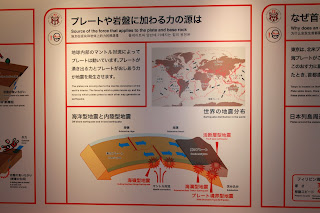The final answer to the ultimate question: what is located beneath the houses at Tokyo Decks? Adult diapers! And much, much more.
After departing from the Minato Ward City Hall our group of about 15 people departed for Odaiba, driving across the Rainbow Bridge. We arrived at the Tokyo Rinkai Disaster Prevention Park, where we got a full tour of the facilities and experienced an extremely frightening disaster simulation!
The disaster complex operates as an emergency backup facility in case the regular disaster management centers (such as the one in Saitama visited in the previous trip) have themselves become nonoperational due to a disaster. It can facilitate 246 people in the main communication room (there are two additional rooms), has a diesel operated generator for power supply, has space for 7 helicopters of any size, and lends out sports materials to families for playing on the grounds when there are no drills scheduled. I was very happy to meet another GRIPS student who lives in the Odaiba facilities.
In the exhibition section the emergency survival packages of several different countries are displayed, as well as games from different countries that teach children how to deal with disasters. During our tour our guide Mori-san showed us a new prototype temporary house, explained why this building was extremely safe (there are also anti-liquefaction measures in place), and then we started our Nintendo DS supported earthquake simulation experience.
Basically after a major disaster the governmental support is expected to not be able to reach the affected area for 72 hours. If you are injured or your house is destroyed, you can come to an emergency center for support. If not, you are expected to survive 72 hours in your house or office, by yourself. This tour makes you experience a major earthquake in a warehouse elevator, after which you walk outside in disaster struck streets. All the while you answer questions for the DS quiz, rating your survival. After this, there is a short movie about the roughly 6.5 million people who would have to travel home from their job in case the earthquake strikes Tokyo in daytime. Finally there is a highly educational section with tips on how to survive, using bottles as furniture and folding flyers into cups and plates. Having survived, we got a solar powered key chain light as reward. Outside our attention was drawn toward the panels between the Disaster Prevention building and the surrounding park. These will break and fall down during a major earthquake, due to the special shock absorbers in the building itself.
The second part of the trip led us close to Odaiba's artificial beach and right next to Tokyo Decks. This is one of Minato Ward's Civic Centers. They have public functions like a library, acting stage and rent-able conference rooms, and also have stockpiles for disasters (there are 107 stockpiles in total in this ward). In the Minato Ward there are about 200,000 Japanese inhabitants and 20,000 foreigners. However in day time there are about 900,000 people commuting and working. Currently the facilities are prepared to cater to 40,000 people who are injured or whose house is destroyed in case of a disaster. For this reason Minato Ward has asked the major companies in the district to arrange a stockpile for their own employees.
The director of the Civic Center showed us boxes with carpets, rive, water, gasoline, portable toilets, rescue equipment, first aid kits (medication stored in the refrigerator), radios... a disaster almost seems manageable with this amount of preparation. Of course it only works if people know these places exist. We returned to the Minato Ward City Hall to see the Tokyo Tower lit up beautifully. Today really showed once again how important it is to have an emergency stockpile at home, at the office, and to inform your family beforehand what your plan is when a disaster occurs.

























No comments:
Post a Comment